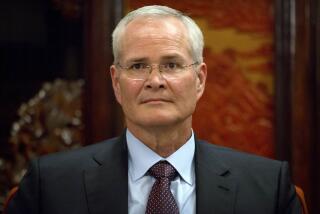Used to Giving Heat, Fund Chief Is Now Getting Some : Pensions: CalPERS’ Dale Hanson finds himself in a fight over patching the state budget.
- Share via
SACRAMENTO — Growing up in southern Wisconsin in the 1950s, Dale M. Hanson seemed to have good political instincts, and his family thought he might someday aspire to run for governor.
But at about age 12, he got his fill of being chased by neighbors’ dogs as he handed out campaign leaflets for his father, a dry cleaner whose passion was local politics.
“I think my interest in politics ended right about there,” Hanson said. “It’s, I think, a very thankless profession.”
Having eschewed elective office for another form of public service--heading the California Public Employees Retirement System--Hanson nonetheless today finds himself in the thick of a heated political battle with nationwide implications.
This week, Gov. Pete Wilson unveiled plans to tap the $62.4-billion CalPERS pension fund to help close the state’s $14.3-billion budget deficit. Wilson further proposed changing the makeup of the CalPERS board, which critics say effectively would make the board beholden to him.
The challenge from Wilson turns the tables on Hanson, himself a challenger who has questioned some of the business practices of corporate America. As chief executive of CalPERS, Hanson has become an outspoken crusader for shareholder rights--ruffling some feathers and gaining some kudos along the way.
The immediate battle stems from Wilson’s proposal to use $1.6 billion in CalPERS’ assets to close the state’s budget deficit and to replace the fund’s 13-person board with a new nine-member panel, five of whom he would appoint. The effort has drawn nationwide attention as other jurisdictions search for ways to balance their budgets.
Hanson’s initial response to Wilson’s plan was to contend that it smacked of a “hostile takeover” designed to muzzle the fund’s shareholder activism. But by midweek, Hanson was sounding more like the consensus-builder that many consider him.
“I’m hoping that the governor will take us up on our offer to meet and figure out a way that we can be of assistance,” Hanson said in an interview last week in the courtyard of CalPERS’ sleek office building in Sacramento. “I hope it won’t be a macho mano a mano thing.”
Indeed, hand-to-hand combat is hardly the style of this 48-year-old Hanson, who became CalPERS’ chief executive in 1987 when the board was in turmoil. His firm but evenhanded style helped secure peace among the disparate group, made up of representatives from management, labor and government.
That accomplished, Hanson pushed into the vanguard of the institutional-shareholder movement, promoting shareholder clout and management accountability in confrontations with some of the biggest U.S. companies.
Earlier this year, CalPERS took on ITT Corp. over management compensation and backed a dissident shareholder’s unsuccessful effort to get a seat on the board of struggling Sears, Roebuck & Co. In years past, it briefly backed investor Harold Simmons’ hostile takeover attempt at Lockheed and filed a lawsuit against Occidental Petroleum over the building of a museum to hold artworks of Armand Hammer, Occidental’s late chairman.
In the process of this high-profile activism, Hanson has won over a Who’s Who of executives. He speaks often with Texaco President James W. Kinnear about shareholder concerns and is friendly with Bruce Atwater, chief executive of General Mills.
When the Air Force recently chose Lockheed over Northrop to produce its top-of-the-line jet fighter, Lockheed Chairman Daniel M. Tellep, letting bygones be bygones over the Simmons proxy fight, sent Hanson a model of the company’s F-117. It has a prominent place in Hanson’s office.
Hanson admits to being flattered by such attention, but he claims that the relationships have not gone to his head.
“There is the potential that you could become swell-headed in a position like this,” said Hanson, who chain-smoked Camels and Winstons during the interview. “But I always remember my humble beginnings.”
The second of four children, Hanson grew up in Madison. After graduating from the University of Wisconsin in 1967 with a business degree, Hanson became a state administrator in the benefits area. Seven years later, he was named the state’s director of group insurance. In 1982 he became deputy secretary and later chief operating officer, the No. 2 position, of the Wisconsin Retirement System.
In 1987, although an unknown in California, he was presented as an alternative candidate when the CalPERS board, which had fired its top administrator, was split between two other hopefuls.
State Controller Gray Davis, a CalPERS trustee, recalled that Hanson seemed “thoughtful and understood the importance of CalPERS.” Davis told colleagues on the board that Hanson was “the best man” and carried “no baggage.” The board chose him by unanimous vote.
Hanson maintains that his corporate-governance crusading would not have come naturally. Rather, he views it as a legacy of Jesse Unruh, the late California state treasurer who helped create the shareholder movement and co-founded the Council of Institutional Investors.
But Hanson clearly has embraced the role, spending hours each week traveling to corporate offices for high-level meetings. His hobbies--scuba-diving and cycling--have largely fallen by the board as a result of his 60-hour workweeks.
Although willing to take an adversarial stance, Hanson seems generally to prefer working with management behind the scenes. In this year’s proxy season, he noted, CalPERS withdrew 10 of 12 proposals because the companies agreed to consider or make changes.
Atwater, General Mills’ chief executive, described Hanson as a pragmatist capable of shifting gears quickly. “As he moves into a situation, he spots what might be the better way to go,” Atwater said.
Jim Burton, the state’s deputy controller, said Hanson’s personable, non-threatening manner has won widespread respect.
“What I have observed is a significant growth in Dale as an individual, an ability to rise to the occasion and handle the job that has jumped up at him,” Burton said.
The fund also has performed well. In the five years ended June 30, the fund earned an annual return of 13.3%, above average for such funds.
There are detractors. Some members of the board complain that he has favored the glamorous investment side and slighted the benefits and services side of the fund, which can more directly affect the more than 900,000 beneficiaries. And many executives wonder why pension funds should be clamoring to help run businesses that they know little about.
As for Wilson’s attempt to reconfigure the board and tap the fund’s assets, Hanson sounds philosophical but resolute. While he understands the budget problem, he says he is bound by law to protect the fund.
“We have duties as fiduciaries to protect the trust, “ he said.
Although he’s in the hot seat, Hanson contends that there is no place he would rather be. “This is a good issue, and we’re on the side of right,” he said. “Something like this certainly gets the energy level up.”
More to Read
Inside the business of entertainment
The Wide Shot brings you news, analysis and insights on everything from streaming wars to production — and what it all means for the future.
You may occasionally receive promotional content from the Los Angeles Times.











